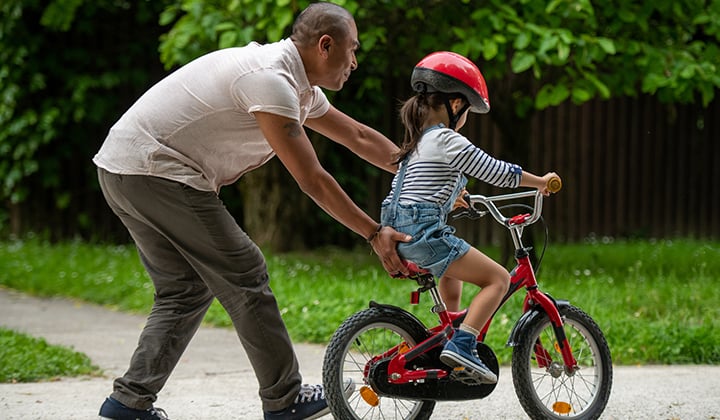When do you need a bike helmet? Your bike safety questions answered.

We all love the freedom and fun bikes can bring for children. It’s such a fun milestone for any kid when they move from training wheels to only using 2 wheels. Then, they can go on long family bike rides or zip over to their friend’s house. Even bike to school! As you start to hit the road, remember these bike safety tips.
Are bikes dangerous?
It’s often not thought of, but bikes can be dangerous. In 2019, there were 114,283 emergency room visits in the US from bicycle-related injuries of children ages 0 to 19. Bike-related injuries can include:
- Contusions and abrasions from falling off the bike, sometimes called road rash.
- Concussions, especially if the rider is not wearing a helmet.
- Brain injury.
- Broken or fractured bones.
- Death.
Ways to protect children from bike injuries
This may sound scary, but there are ways to help protect your child when they are riding their bike.
- Always wear a properly fitting helmet – every time your child rides a bike.
- Teach kids how to ride a bike – starting, stopping, proper bike fit and how to stay alert when riding.
- Use sidewalks or well-defined bike lanes. If it is not available, ride with the flow of traffic, sticking to the right side of the lane.
- Teach kids the rules of the road including street sign meetings and how to use hand signals to communicate.
- Show kids how to look left, right, and left a second time before crossing a street or intersection.
- Have your child wear brightly colored clothing and reflective clothing or blinking lights to help them be more visible to others. Try to avoid loose or long clothing.
- Ride with your child until you feel comfortable for them to ride by themselves. Children often struggle with understanding distance and speed of cars until they are around the pre-teen age.
How to check bike fit for children
It’s important to make sure the bike your child is riding fits properly and is working correctly.
- A child’s feet should be able to touch the ground when sitting on the bike seat.
- A child should be able to reach the handlebars and the brake levers.
How to check the fit of a helmet
Children and adults of all ages should be wearing a helmet every time, for every ride. Look for a bike helmet certified by the U.S. Consumer Product Safety Commission to ensure it’s been tested for safety and meets the federal safety standards.
There are 4 things to check to make sure your helmet fits correctly. If it’s not the correct fit, the helmet can’t do its job of protecting the head from injury.
EYES: When the helmet is on the head, your child should be able to see the rim of the helmet when they look up. The rim should be 1-2 finger-widths above the eyebrows, no more and no less.
EARS: Make sure the helmet straps form a “V” under the ears when they’re buckled.
MOUTH: When your child opens their mouth, does the helmet feel snug on their head? Tighten straps if they’re loose and make sure they lay flat against their skin. The helmet should feel snug around the head, so it can help always protect your child.
The last rule is to make sure your child likes their helmet. The more they like it, the more likely they’ll wear it. So, offer to let your child pick out the color, design, or style. As long as it fits properly, 2 thumbs up!
After any crash, major fall or impact it’s time to replace the helmet. Sometimes the damage to the protective foam and padding isn’t easily seen. Any helmet with cracked, broken, or missing pieces should also be replaced.
Related articles:
5 Most preventable childhood injuries

